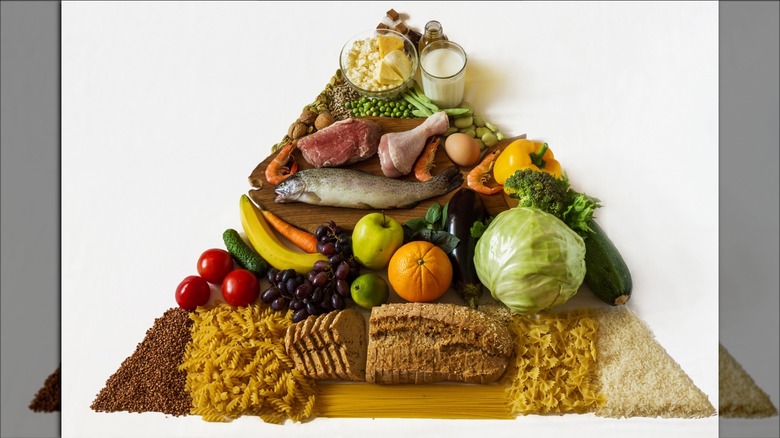TikTok Is Shocked About This Food Pyramid Origin Story
On August 24, Danielle Allen, RD, uploaded a video to @eathappierdietitian, their dietician TikTok account. It quickly spread over the platform, becoming a featured post. The reason? To highlight the absurdity of the Food Pyramid and the forces that led to its creation.
In Allen's account, the American government worried that due to food rationing during World War II, the public would not eat all the nutrients they needed. This led them to issue a list of seven basic foods, suggesting that Americans should eat a little bit every day. "And anything else you want," Allen adds sarcastically.
In 1992, this changed with the introduction of the Food Pyramid. No longer was the government simply saying that you should have a bit of everything, but now there was a hierarchy. The base of the pyramid was grains, lots of grains. Too many grains. According to Allen, fruits and veg were originally supposed to have the most important spot, but the bread industry lobbied heavily and other changes were pushed by the meat, sugar, and dairy industries.
As of writing, Allen's video has been viewed 269.2K times and has received 12.8K likes. WKYC Studios noticed the video's popularity and decided to verify it. It found that the story Allen tells is broadly true, though they did not weigh in on the point that the Food Pyramid had been altered for corporate interests.
Fixing the Food Pyramid
The problems with the Food Pyramid become obvious under any level of scrutiny. Dr. Marion Nestle, a retired professor of nutrition, food studies, and public health at New York University, noted in WKYC Studios' fact check that eating six to eleven servings of grain every day would lead to enormous weight gain.
Harvard's School of Public Health also pointed out that it simply gave bad advice. It demonized healthy oils, lumped good proteins with processed meat, and made dairy too important.
So, how does one fix this? Well, in 2005, the Food Pyramid was updated into the My Pyramid, which flipped the pyramid's layers on their side. However, Harvard finds it "vague and confusing." There wasn't any explanatory text, meaning that only people who took the time to learn what they were looking at might have benefited.
Eventually, everyone realized that the tweak didn't help at all and replaced My Pyramid with My Plate, which changed the abstract hierarchy of a pyramid to a plate. Allen loved this one, and thought it better represented serving sizes. However, the even better alternative is the Healthy Eating Plate, which you can find on the School of Public Health's website. It removes the needed servings, opting instead to show proportionately how you should eat. It returns precedence to veggies, labels healthy oil as a viable inclusion, and removes dairy entirely.

